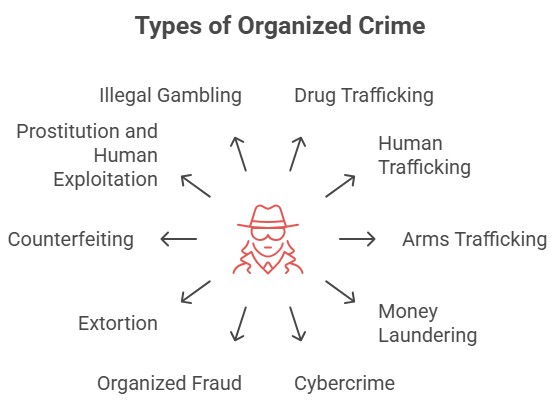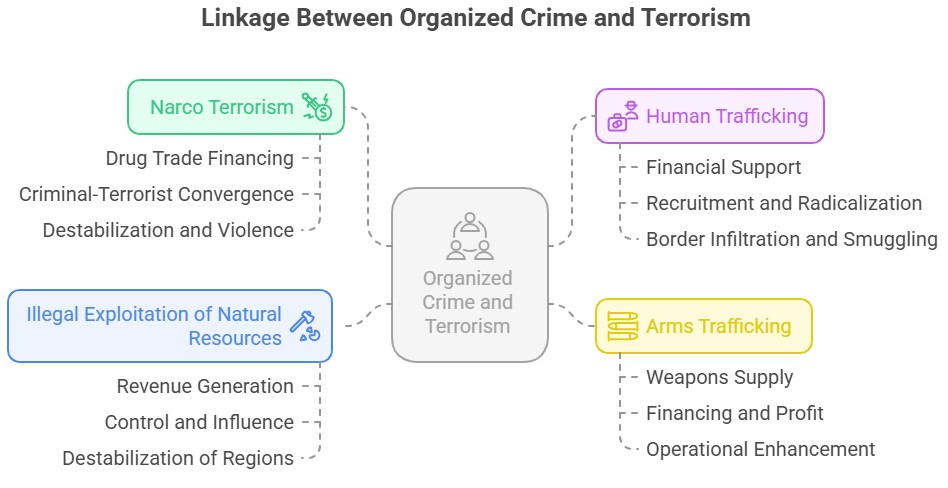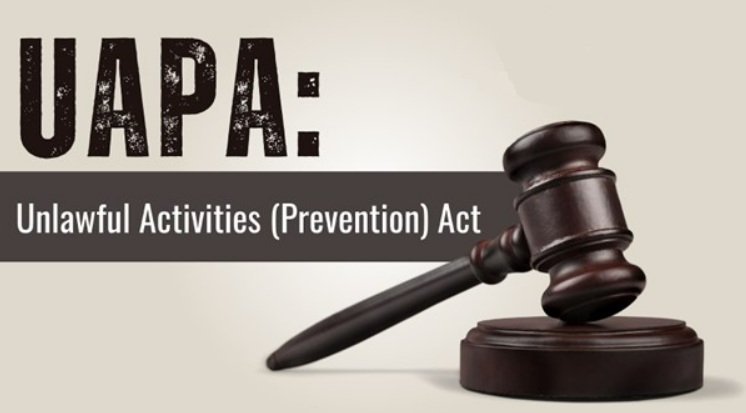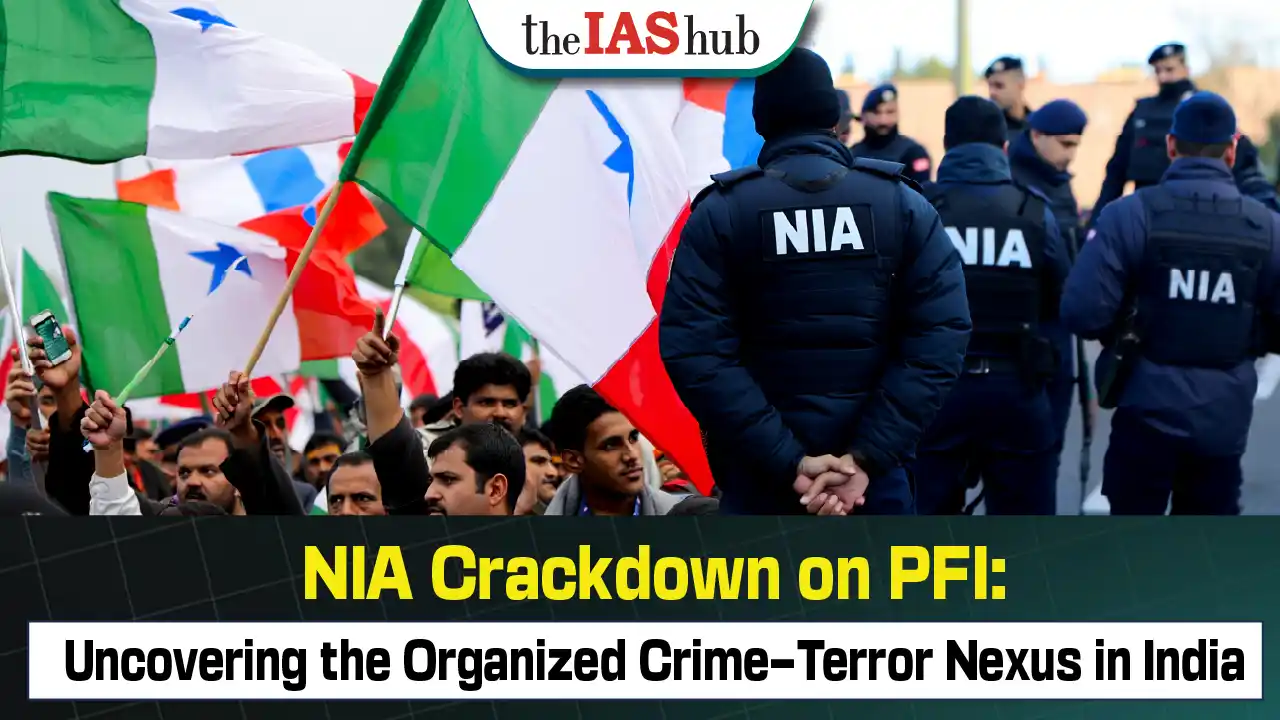India faces an evolving security challenge as organized crime increasingly overlaps with terrorism, fueling violence and destabilization. Recent actions by the National Investigation Agency (NIA) against groups like the Popular Front of India (PFI) highlight this growing nexus.
Recent context
Recently the National Investigation Agency (NIA) has launched a massive nationwide search operation in connection with anti-terror activities linked to the Popular Front of India-PFI for alleged terror links.


Types of Organized Crime
- Drug Trafficking: The illegal production, transportation, and distribution of controlled substances, such as narcotics and illegal drugs.
- Human Trafficking: The recruitment, transportation, harbouring, or exploitation of individuals through force, coercion, or deception for purposes such as forced labour, sexual exploitation, or organ harvesting.
- Arms Trafficking: The illegal trade and distribution of firearms, ammunition, explosives, and other weapons.
- Money Laundering: The process of making illegally obtained money appear legitimate by disguising its true source through a series of transactions and financial manipulations.
- Cybercrime: Criminal activities carried out using computers, networks, and the internet, including hacking, identity theft, online fraud, and data breaches.
- Organized Fraud: Large-scale fraud schemes, such as insurance fraud, credit card fraud, securities fraud, or Ponzi schemes, involving multiple participants and organized networks.
- Extortion: The act of obtaining money, property, or services through coercion, intimidation, or threat of violence.
- Counterfeiting: The production and distribution of fake or unauthorized copies of currency, documents, merchandise, or branded products.
- Prostitution and Human Exploitation:Organized networks involved in the trafficking and exploitation of individuals for sexual purposes.
- Illegal Gambling: Illicit operations involving sports betting, casinos, card games, or other forms of gambling outside the bounds of legal regulations.

Characteristics of Organized Crime
- Structure: Hierarchical organization resembling a business.
- Long-Term Operation: Engages in illegal activities over an extended period.
- Specialization: Members specialize in specific criminal activities.
- Continuity: Operates continuously, adapting to circumstances.
- Profit-Driven: Primary motive is financial gain through illegal activities.
- Violence and Coercion: Employs force and intimidation.
- Corruption and Influence Infiltrates sectors and uses bribery.
- Global Reach: Operates across borders and utilizes global networks.
Linkages Between Organized Crime and Terrorism
Terrorism is a distinct form of organized criminal behaviour that aims to intimidate a population or coerce governments and international organizations in order to achieve political or social objectives through:
- Financing: Organized crime provides financial support to terrorist groups through illicit activities.
- Collaboration: Organized crime and terrorists cooperate based on shared interests and resources.
- Weapons and Logistics: Organized crime networks supply terrorists with weapons and logistical support.
- Cross-Border Movements: Organized crime's smuggling routes are utilized by terrorists for movement.
- Money Laundering: Organized crime assists terrorists in laundering illicit funds.
- Corruption and Bribery: Organized crime's influence creates vulnerabilities that terrorists can exploit.
Challenges in Controlling Organized Crime
- Absence of specific legislation, Lack of coordination of Law enforcement agencies, slow trials, Economic disparity, Emerging markets of crime, Emerging technology.
Case Studies Showing Linkage Between Organized Crime and Terrorism
Narco Terrorism
- Drug Trade Financing: Terrorist groups collaborate with or engage in drug trafficking to fund their operations.
- Criminal-Terrorist Convergence: Drug cartels and terrorists merge or collaborate, utilizing drug networks for their activities.
- Destabilization and Violence: Narco-terrorism fuels violence, corruption, and societal disruption, threatening security, and stability.
- Global Impact: Narco-terrorism affects multiple countries, undermining governance and posing challenges for law enforcement and counterterrorism efforts.
|
Global Example
- Taliban: The Taliban in Afghanistan is known to have profited from the opium trade, particularly in the Helmand province, where they tax and protect poppy farmers and drug traffickers.
- Hezbollah: Hezbollah, a Lebanese militant group, has been involved in narco-terrorism. They have engaged in drug trafficking, money laundering, and other illicit activities to generate funds for their operations in the Middle East.
|
India Specific Example
- Lashkar-e-Taiba (LeT) and Drug Trade:
Lashkar-e-Taiba, a Pakistan-based terrorist organization, has been linked to narco-terrorism activities in India. LeT has reportedly been involved in the drug trade in the Kashmir region, using proceeds from drug trafficking to finance its militant operations against Indian security forces.
|
Human Trafficking
- Financial Support: Human trafficking provides revenue for terrorist organizations.
- Recruitment and Radicalization: Terrorist groups exploit human trafficking networks to recruit and radicalize individuals.
- Border Infiltration and Smuggling: Human trafficking routes are used by terrorists for infiltration and smuggling.
- Exploitation of Vulnerable Communities: Both crimes prey on vulnerable populations, with terrorists exploiting human trafficking victims for labour, exploitation, and recruitment.
|
Global Example
- Boko Haram: The Nigerian terrorist group Boko Haram has been known to engage in human trafficking activities. They abduct women and girls, using them as sex slaves and forced laborers. In addition to the horrific exploitation of victims, Boko Haram has reportedly used the proceeds from human trafficking to fund their terrorist activities, including bombings and attacks.
|
India Specific Example
- Rohingya Crisis: In India, the influx of Rohingya refugees from Myanmar has raised concerns about the connection between human trafficking and terrorism. It is reported that some Rohingya refugees, particularly vulnerable women, and children, have been targeted by human trafficking networks. There are concerns that terrorist elements may take advantage of the precarious situation to recruit individuals or exploit the refugee population for their activities.
|

Arms Trafficking
- Weapons Supply: Arms trafficking provides terrorist groups with access to firearms and explosives.
- Financing and Profit: Arms trafficking generates revenue for both arms dealers and terrorist organizations.
- Operational Enhancement: Illicit weapons enhance the operational capabilities of terrorists for attacks and control.
- Destabilization and Conflict Fuelling: Arms trafficking contributes to regional instability and fuels conflicts, enabling terrorists to exploit power vacuums.
|
Gobal Example
- Al-Shabaab: Al-Shabaab, an extremist group based in Somalia, is known to engage in arms trafficking to sustain its operations. The group smuggles weapons across porous borders, acquiring firearms, explosives, and other weaponry. These illicit arms enable Al-Shabaab to carry out attacks, maintain control over territories, and continue its campaign of violence and terror.
|
India Specific Example
- In Jammu and Kashmir, terrorist groups like LeT and JeM procure weapons through arms trafficking networks from Pakistan. These weapons are smuggled across the border and used in attacks on Indian security forces and civilians.
|
Illegal Exploitation of Natural Resources
- Revenue Generation: Terrorism is funded through the illegal exploitation of natural resources.
- Control and Influence: Control over valuable resources gives terrorist groups power and influence over local populations.
- Destabilization of Regions: Illegal resource exploitation fuels instability in conflict zones and weak governance areas.
- Global Networks: Transnational criminal networks facilitate the illicit trade of natural resources, strengthening the link between terrorism and resource exploitation.
|
Global Example
- In the DRC, armed groups, including terrorist organizations like Demacratic Forces for the Liberation of Rwanda (FDLR), exploit minerals like tantalum, tin, tungsten, and gold. They control mines, extort locals, and profit from the trade of these conflict minerals to fund their operations and sustain violence.
|
India Specific
- Coal Smuggling in Jharkhand: In the state of Jharkhand, illegal coal mining and smuggling have been linked to the financing of terrorist activities. Terrorist groups, such as Naxalite-Maoist organizations, are known to extort money from coal mine owners and engage in the illicit trade of coal. The profits derived from these activities are used to fund their operations and sustain their insurgency.
|
Measures to Tackle Organized Crime
- Strengthen law enforcement: Enhance resources and training for police to combat organized crime.
- International cooperation: Collaborate across borders to share information and joint operations.
- Enact and enforce targeted legislation: Pass laws against money laundering, corruption etc.
- Disrupt financial flows: Strengthen financial intelligence units and cooperate to track illicit funds.
- Community engagement: Educate and involve communities in reporting organized crime.
- Target leadership and infrastructure: Dismantle criminal networks through asset seizures.
- Embrace technology: Utilize data analytics and digital monitoring to detect & prevent organized crime.
- Enhance border controls, Fight corruption
Steps to Counter Organized Crime–Terrorism Nexus
|
Global level
- The Security Council adopted resolution 2482, which urged Member States to address the links between organized crime and terrorism.
- Creation of a financial action task force (FATF) to deal with issues of money laundering and terror funding.
- UNODC (United Nations office on Drug and crime) supports efforts to tackle the link between organized crime and Terrorism.
|
India Specific
- Unlawful Activities (Prevention) Amendment Act, 2019.
- National Investigation Agency Act, 2008
- Narcotic Drugs and Psychotropic Substances Act, 1985.
- Laws under IPC and CRPC to control unlawful activity.
|
In News: Unlawful Activities (Prevention) Act, (UAPA) 1967
Recent Context
- In a significant ruling, a three-judge bench of the Supreme Court held that mere membership in a banned association is adequate to establish an offense under the Unlawful Activities (Prevention) Act, 1967.

About the Act
- Declaration of Unlawful Associations: Section 3 empowers the central government to declare an association as unlawful if it is involved in activities deemed unlawful and endangering India's unity and integrity.
- Bail Restrictions: Section 43D (5) of the Act limits judicial discretion in granting bail under the UAPA. Penalties: The UAPA provides for severe punishments, including death penalty and life imprisonment, for those found guilty of unlawful activities.
- Applicability: The UAPA applies to both Indian and foreign nationals, even if the crime is committed outside India, ensuring equal treatment of offenders.
- Amendments:
- The 2004 amendment expanded the scope of unlawful activities to include terrorism-related offenses.
- The 2019 amendment empowered the government to designate individuals as terrorists based on their involvement in terrorist acts or promoting terrorism.
- It also granted additional powers to the National Investigation Agency (NIA) and incorporated the International Convention for the Suppression of Acts of Nuclear Terrorism.
|
Concerns Related to UAPA act
- Misuse: UAPA is often misused to suppress dissent and target critics.
- Lack of transparency: Prolonged detention without bail raises transparency concerns.
- Vague definitions: Broad definition of "unlawful activities" allows subjective interpretation.
- Federalism concerns: NIA's powers encroach on state authority in policing.
- Denied bail: Section 43D (5) restricts bail based on prima facie allegations.
- Burden of proof: Accused bear burden of proof, unlike other criminal offenses.
- Low conviction rate: Slow functioning of NIA courts leads to low conviction rate.
- Unreported crime incidents: Many cases lack documented incidents, as per the PUCL report (about 64% of the cases involving Section 18 charges like penalty for conspiracy, etc. had no incidents that have been documented).
|
Way Forward
- Freedom and security: Individual freedom and national security must harmoniously coexist for India's democracy.
- Court's assessment: The court must determine if the UAPA's scope aligns with its objectives without disproportionately affecting individual rights.
- Balanced law: A law is needed that effectively combats terrorism while respecting constitutional requirements.
- Counterterrorism priority: Locating, eliminating, and prosecuting terrorists should be a top priority.
- Striking a balance: Upholding democratic values requires finding the right balance between civil liberties and national security.
|
Conclusion
Collaboration between technology, manpower, and intelligence is vital in countering organized crime and terrorism. Establishing links between crime syndicates and terrorism through refined investigations is necessary. Developing shared strategies and strengthening international coordination is crucial to tackle the emerging nexus. Together, we can effectively combat these threats and ensure safety and security.
















